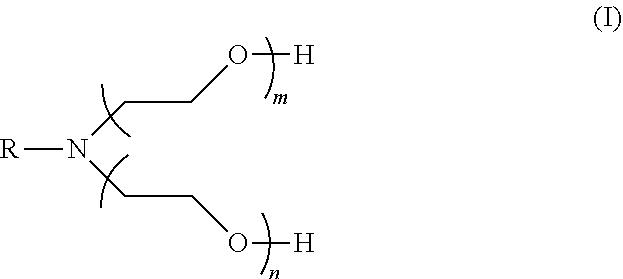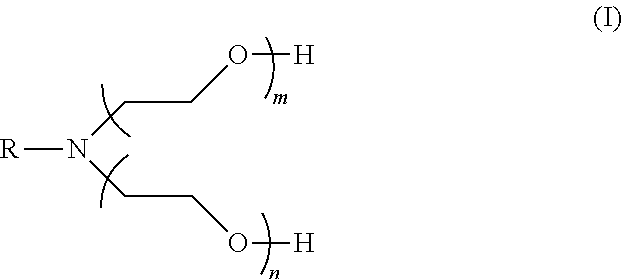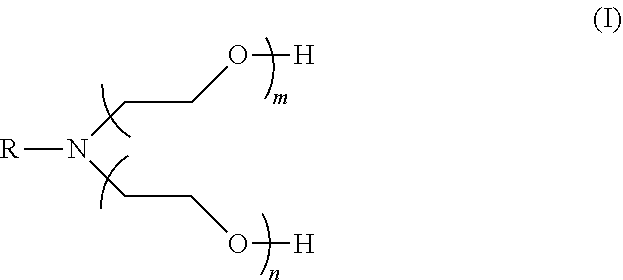Chemical mechanical polishing composition and method for tungsten
a technology of mechanical polishing and composition, applied in the direction of polishing composition, other chemical processes, aqueous dispersions, etc., can solve the problems of large complexity involved in cmp, corrosion of tungsten, non-uniform or non-planar surfaces, etc., to inhibit unwanted tungsten corrosion and inhibit dishing and erosion
- Summary
- Abstract
- Description
- Claims
- Application Information
AI Technical Summary
Benefits of technology
Problems solved by technology
Method used
Image
Examples
example 1
Slurry Formulations
[0066]The chemical mechanical polishing compositions of this Example were prepared by combining the components in the amounts listed in Table 1 with the balance being DI water and adjusting the pH of the compositions to the final pH listed in Table 1 with 45 wt % potassium hydroxide.
[0067]
TABLE 1OleylamineMalonicPolishingAbrasive1EthoxylateFe(NO3)3AcidH2O2Slurry #(wt %)(ppm)(ppm)(ppm)(wt %)pHControl2—362132022.5PS-1210362132022.5PS-2230362132022.5PS-3250362132022.5PS-42500362132022.5PS-5230362132022.5PS-6250362132022.5PS-72500362132022.5PS-8230362132022.5PS-9230362132022.5 PS-10230362132022.51KLEBOSOL ™ 1598-B25(−) zeta potential abrasive slurry manufactured by AZ Electronics Materials, available from The Dow Chemical Company.
[0068]
TABLE 2Polishing Slurry #Oleylamine Ethoxylations (M + n)PS-13PS-23PS-33PS-43PS-55PS-65PS-75PS-810PS-915 PS-1020
example 2
Corrosion Rate Inhibition Performance of Oleylamine Ethoxylate CMP Slurries
[0069]The corrosion tests were carried out by immersing W blanket wafers (1 cm×4 cm) in 15 g slurry samples. The W wafers were removed from tested slurries after 10 min. The solutions were subsequently centrifuged for 20 min at 9,000 rpm to remove slurry particles. The supernatant was analyzed by ICP-OES to determine the amount of tungsten by weight. The corrosion rate (Å / min) was converted from the W mass assuming an etching wafer surface area of 4 cm2. The results of the corrosion tests are in Table 3.
[0070]
TABLE 3Polishing Slurry #W Corrosion Rate (Å / min)Control35PS-130PS-23.2PS-31PS-4PS-521PS-610.5PS-7PS-822PS-926 PS-1035
[0071]The results of the corrosion rate tests showed that the chemical mechanical polishing slurries which contained the oleylamine ethoxylates with ethoxylations (m+n) of 3, 5 10 and 15 significantly reduced the corrosion of W on wafers in contrast to the control which excluded the oleyl...
example 3
[0072]
TABLE 4Slurry FormulationsFattyAmineMalonicPolishingAbrasive1EthoxylateFe(NO3)3AcidH2O2Slurry #(wt %)(ppm)(ppm)(ppm)(wt %)pH2Control2—362132022.5PS-11250362132022.5PS-122500362132022.5PS-13250362132022.5PS-142500362132022.51KLEBOSOL ™ 1598-B25(−) zeta potential abrasive slurry manufactured by AZ Electronics Materials, available from The Dow Chemical Company.2pH adjusted with 45 wt % potassium hydroxide.
[0073]
TABLE 5Fatty Amine Ethoxylates + EthoxylationsPolishing Slurry #(m + n)PS-11Cocoamine Ethoxylate 20PS-12Cocoamine Ethoxylate 20PS-13Stearylamine Ethoxylate 20PS-14Stearylamine Ethoxylate 20
PUM
| Property | Measurement | Unit |
|---|---|---|
| flow rate | aaaaa | aaaaa |
| pH | aaaaa | aaaaa |
| particle size | aaaaa | aaaaa |
Abstract
Description
Claims
Application Information
 Login to View More
Login to View More - R&D
- Intellectual Property
- Life Sciences
- Materials
- Tech Scout
- Unparalleled Data Quality
- Higher Quality Content
- 60% Fewer Hallucinations
Browse by: Latest US Patents, China's latest patents, Technical Efficacy Thesaurus, Application Domain, Technology Topic, Popular Technical Reports.
© 2025 PatSnap. All rights reserved.Legal|Privacy policy|Modern Slavery Act Transparency Statement|Sitemap|About US| Contact US: help@patsnap.com



